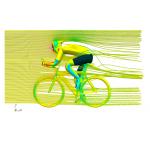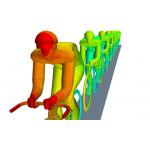Latest News
August 1, 2005
By Stephen Ferguson and Ross Zellat
Perhaps more than any other sport, top-level cycling is dominated by aerodynamics and, more specifically, the art of drafting. Drafting is when one cyclist rides in the wake of another, reducing exposure to the oncoming air and ultimately the energy expended in cycling. But how much energy is a topic of some debate. Before this year’s Tour de France CD-adapco undertook a comprehensive CFD simulation to find the answer.
The influence of aerodynamics is most visible in the time-trial stages of the Tour de France. The time-trial comes in two distinct flavors: an Individual Time Trial (ITT) and a Team Time Trial (TTT). ITT riders compete alone. With no other riders to draft behind, the ITT is known as “the race of truth,” a brutal contest of man and machine against the clock. TTT riders compete as a team of up to nine riders. Each rider takes a turn at the front of the paceline, bearing the full force of the oncoming air and providing a wake in which teammates draft. As riders tire, they swing off the front and drift back to the rear, recovering in the wake of the other riders before their next turn at the front.Although time-trialing ability alone is not enough to win the Tour de France, come July the final recipient of the yellow jersey is almost certain to be a time-trialist of supreme ability. Recent Tours have almost always been won by riders that dominate the time-trial stages; 5 times winner Miguel Indurain and 6 time winner Lance Armstrong typically based their victories around large time gaps opened up in the time-trial stages.
Cycling is a sport in which every second really does count and small aerodynamic advantages can be the difference between winning and losing the Tour. In 1989 Greg Lemond trailed French rider Laurent Fignon by 50 seconds prior to the final stage, a 24.5km ITT. To most observers, this gap seemed insurmountable - requiring Lemond to ride each kilometer 1 second faster than Fignon, himself no mean time-trialist. On a warm Paris afternoon Lemond, wearing an aerodynamic helmet and riding a special aerodynamic bicycle, beat Fignon, riding a normal road bike, by 58 seconds, winning the Tour by just 8 seconds. Subsequent analysis has suggested that the drag on Fignon’s ponytail alone was enough to slow him down by the critical 8 seconds by which he lost the race. The TTT played a large part in deciding the winner of the 2003 Tour; of his 61 second margin Lance Armstrong won 43 seconds in the Team Time Trial.
|
|
|
|
By performing CFD simulations of a nine-man TTT and a single cyclist ITT, it is possible to evaluate the influence of drafting. Although individual cyclists have been subjected to wind-tunnel testing, the sheer size of a nine-cyclist paceline makes physical testing impractical. In the CFD world, entire TTT calculations were, until recently, prohibitively expensive, requiring a great number of computational cells to sufficiently resolve the flow past the line of cyclists.
The CFD models were constructed using STAR-CAD Series. STAR-CAD is not restricted to just hexahedral or tetrahedral elements; it can create and solve upon meshes of arbitrary cell topology. Using polyhedral elements (which typically have between 12 and 14 faces), STAR-CAD can provide near hexahedral accuracy with at least five times fewer cells than a typical tetrahedral calculation. The TTT mesh contained almost 7 million polyhedral cells, equivalent in accuracy to a mesh of approximately 30 million tetrahedra.
|
|
|
|
The simulation results were illuminating. Compared with the lead cyclist, the drag of the rider in the second position is reduced by 21%. The third rider feels a further small decrease in drag over the second, but from the third rider back all other cyclists experience almost identical drag.
As the riders continually progress toward the front of the paceline, take a short turn at the front, and then soft pedal as they drift to the rear of the line, the average drag coefficient of a TTT rider (assuming a constant rate of rider rotation and ignoring the effect of dropping back) is around 27% lower than experienced by an individual rider. Perhaps the most surprising conclusion is that, despite the full force of the oncoming air, the lead rider experiences lower drag than if he were riding an ITT at the same speed. The drag coefficient of the leading TTT rider is 0.277, while that of an individual rider is 0.285. This occurs because the second place rider reduces the influence of the lead rider’s wake, increasing his base pressure and consequently reducing the drag force.
Despite the predicted reduction in drag coefficient afforded to riders in a team time-trial, the increase in speed over an individual time trialist is not large. In the 2004 Tour, Armstrong completed the 55km individual time trial with an average of 49.39 km/h; his team won the 64.5km TTT with an average speed of 53.71 km/h. This increase in average speed of just 6% seems relatively small compared to the effort exerted by eight extra cyclists. However, as drag increases with velocity squared, a 4 km/h increase would require much greater effort for an individual rider. One would expect the difference in speed to be much greater if all nine riders were time-trialists of Armstrong’s ability.
In reality, however, cycling teams consist of riders with varying specialities (i.e., climbing, sprinting, leading pacelines) so that the contribution of all nine riders in a paceline is not equivalent. Because of this, the lead rider is sometimes forced to temper his effort so that the lesser time-trialist on the team can keep up, despite the reduction in drag. If gaps open in the line, riders are liable to be left behind, cycling in the wind and unable to catch up.
Stephen Ferguson and Ross Zellat work for CD-adapco’s London office. Send your comments by clicking here. Please reference August 2005 Cycling.
Contact Information
CD-adapco
Melville, NY
Subscribe to our FREE magazine, FREE email newsletters or both!
Latest News
About the Author
DE’s editors contribute news and new product announcements to Digital Engineering.
Press releases may be sent to them via [email protected].








